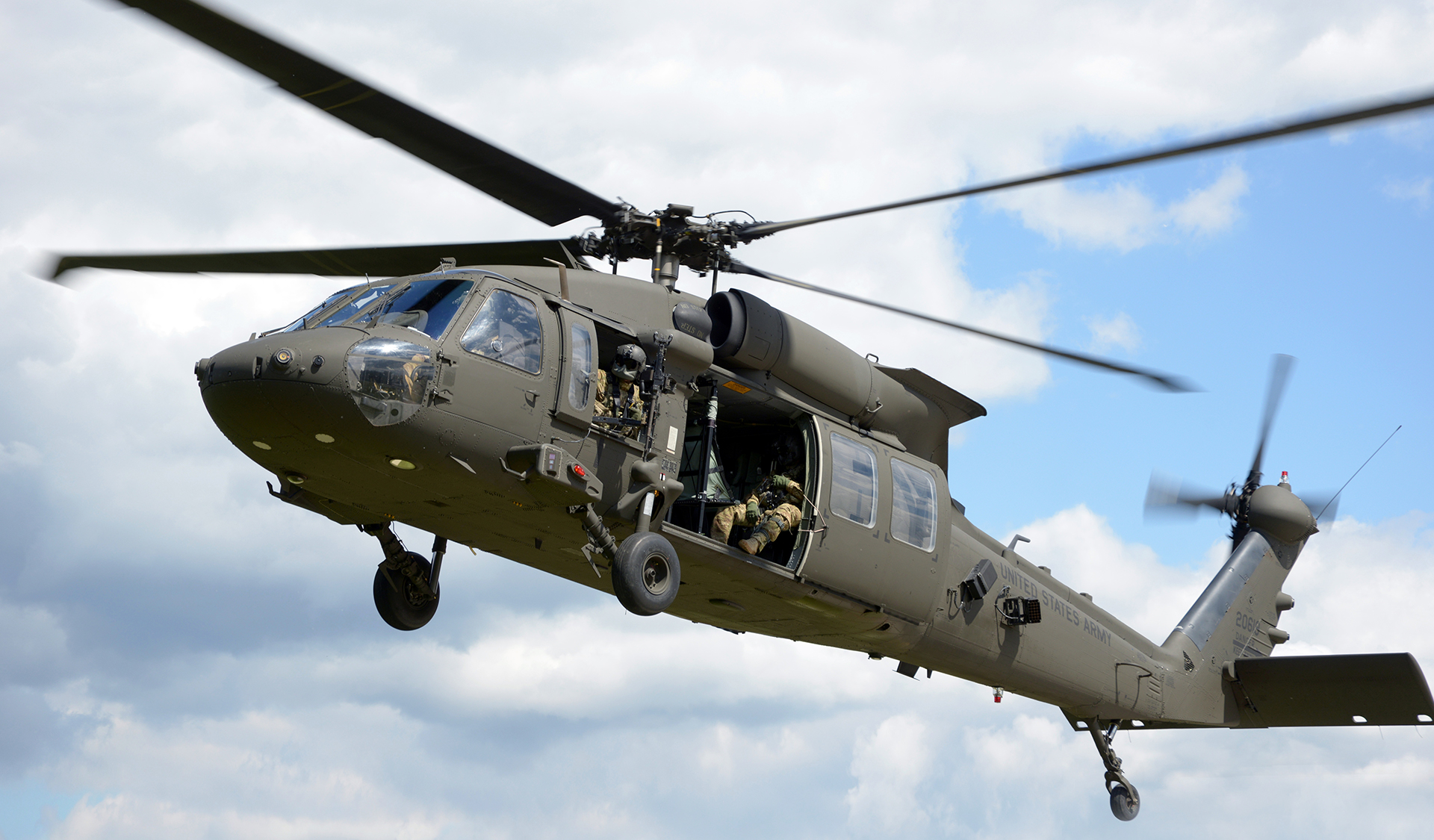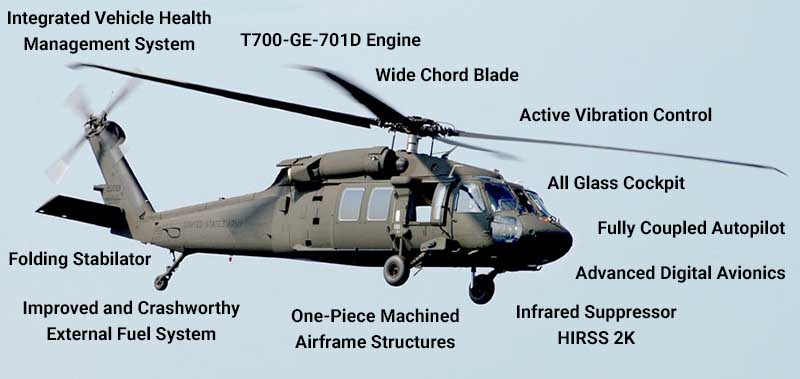The UH 60 Helicopter: Enhancing Wheelchair and Versatility in Armed Force Missions
The UH 60 Helicopter: Enhancing Wheelchair and Versatility in Armed Force Missions
Blog Article
UH-60: Developments in Modern Helicopter Design
The UH-60 helicopter stands as a benchmark in contemporary air travel, showcasing significant innovations in layout and innovation that provide to the developing needs of army procedures. As we explore the evolution and crucial technologies of the UH-60, it comes to be important to consider exactly how these advancements influence not just present applications however likewise the future landscape of helicopter design.

Advancement of the UH-60
The evolution of the UH-60 Black Hawk helicopter stands for a considerable milestone in aerospace engineering and military aeronautics. Introduced in the late 1970s, the UH-60 was designed by Sikorsky Airplane to fulfill the United States Army's need for a versatile energy helicopter with the ability of carrying out a variety of objectives. Its layout emphasized rate, durability, and maneuverability, establishing new criteria for functional performance.
The UH-60 features a distinct four-blade blades system, which boosts lift and stability, enabling it to run effectively in varied environments. Its airframe is created from advanced composite materials, adding to a decrease in weight while maintaining structural honesty. The helicopter's layout likewise incorporates improved the rules of aerodynamics, which boosts gas efficiency and boosts array.
Throughout the years, the Black Hawk has gone through several upgrades to boost its capabilities, including boosted engines, advanced trip control systems, and modular systems for easy upkeep and adaptability. The helicopter's capability to execute goals ranging from troop transport to medical discharge has actually strengthened its role as a foundation of united state army procedures. The UH-60 Black Hawk remains an archetype of how advancement in helicopter layout can significantly impact armed forces effectiveness and operational adaptability.
Advanced Avionics Solutions
Advancements in avionics systems have actually transformed the capabilities of contemporary helicopters like the UH-60 Black Hawk, enhancing operational performance and situational recognition (UH 60). The assimilation of sophisticated avionics enables for improved flight, navigating, and communication monitoring, making the UH-60 a lot more functional in varied objective accounts
Among the vital attributes is the innovative electronic cabin, which utilizes multifunction display screens that give real-time data, making sure pilots have instant access to important trip info. This streamlining of details lessens pilot work and enhances decision-making processes during complicated procedures. Additionally, the incorporation of general practitioner and inertial navigation systems allows accurate positioning and route planning, boosting mission execution in difficult atmospheres.
In addition, progressed avionics systems enhance interaction capabilities via secure data web links and voice communication systems, enabling smooth control with ground pressures and other airplane. The combination of automated trip control systems additionally adds to enhanced stability and control, particularly in damaging weather or throughout low-altitude maneuvers.
Engine and Performance Enhancements
Engine efficiency in modern-day helicopters has actually taken a substantial jump forward, driven by developments that boost effectiveness, reliability, and power. The UH-60 Black click here now Hawk, for instance, uses the T700-GE-701C engine, which includes a dual-channel, full-authority electronic engine control system.
In addition, the integration of engine health and wellness tracking systems enables for real-time diagnostics and predictive maintenance, significantly boosting functional integrity. These systems not just sharp crews to prospective concerns before they end up being essential yet additionally promote much more reliable upkeep organizing, thereby decreasing downtime.

Products and Structural Innovations
Current advancements in products and architectural layout have changed modern-day helicopter construction, enhancing both efficiency and sturdiness. The introduction of sophisticated composite materials, such as carbon fiber reinforced polymers, has dramatically decreased weight while preserving structural integrity. This change not only enhances fuel effectiveness yet additionally raises payload ability, enabling helicopters like the UH-60 to execute more diverse goals.
Furthermore, technologies in aluminum alloys and titanium components have added to boosted resistance to corrosion and exhaustion, expanding the life-span of vital airframe aspects. The calculated use these products has caused a reduction learn this here now in maintenance requirements and boosted overall functional readiness.

Additionally, the assimilation of computer-aided style (CAD) and additive manufacturing modern technologies has enabled extra light-weight frameworks and complicated geometries, maximizing the wind resistant performance of helicopter layouts. These developments help with fast prototyping and production, enabling manufacturers to respond swiftly to progressing mission needs.
Safety And Security and Survivability Features
Safety and security and survivability attributes in modern helicopter design have actually ended up being critical, reflecting the increasing demands for objective efficiency in tough environments. The UH-60 Black Hawk, a significant example, integrates advanced modern technologies to improve crew and guest security.
The helicopter likewise employs a ballistic defense system, that includes armored staff seats and vital systems shielding, minimizing vulnerability to small arms fire and shrapnel. Enhanced situational recognition is attained with sophisticated avionics and sensing unit technologies, allowing pilots to detect and stay clear of threats successfully.
Furthermore, the combination of redundancy in essential systems-- such as double engines and numerous trip control channels-- guarantees ongoing operation also if one system stops working. The UH-60 is outfitted with advanced emergency situation flotation devices, improving survivability in water touchdowns. Collectively, these functions not just improve the safety of personnel but also increase objective success prices in hostile settings, demonstrating the commitment to quality in helicopter layout.
Final Thought
The UH-60 helicopter stands for a significant innovation in modern-day air travel modern technology, integrating ingenious materials, innovative avionics, and robust safety and security attributes. Its advancement mirrors a commitment to improving efficiency and functional effectiveness while guaranteeing pilot and crew survivability. The assimilation of light-weight compounds and progressed navigating systems highlights the helicopter's flexibility in different armed forces missions. On the whole, the UH-60 serves as a benchmark for future developments in helicopter design, symbolizing durability and flexibility in modern military operations.
The UH-60 helicopter stands as a standard in contemporary aeronautics, showcasing substantial advancements in style and innovation that provide to the developing needs of army operations. As we check out the evolution and essential developments of the UH-60, it ends up being crucial to take into consideration just how these developments affect not only present applications however also the future landscape of helicopter layout.
Presented in the late 1970s, the UH-60 was developed by Sikorsky Airplane to meet the United States Army's demand for a functional energy helicopter capable of doing a variety of missions. The UH-60 Black Hawk stays a prime article example of how advancement in helicopter style can considerably influence army performance and functional versatility.
In general, the UH-60 offers as a criteria for future developments in helicopter style, personifying strength and versatility in contemporary army operations.
Report this page